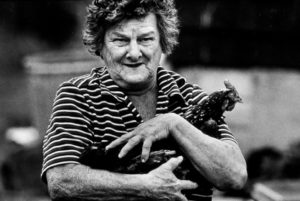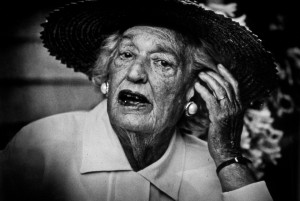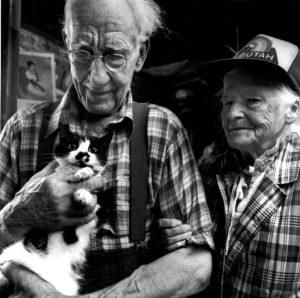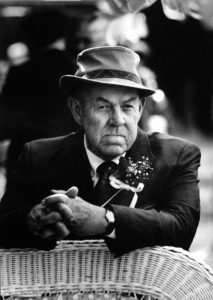Capturing the Elusive Native
When we first came to Islesboro in the summer of 1982, we stayed at the Aldrich House on Ferry Road. Each morning I’d awake to the sound of paint brush slapping against clapboards. I’d bring my cup of coffee outside and talk with Michael Durkee, who was busy painting the house. After sharing our life histories, I asked him if it would be okay if I took his photograph.
Looking me straight in the eye, Mike said, “Trying to capture the elusive native are ya!”
Well, I just about keeled over laughing, because that’s exactly what I was trying to do. I was seeing Mike as an iconic figure in the Maine landscape, almost a symbol of summer. Years later, I drew a cartoon of a Maine lobsterman snoozing against a shed and surrounded by a dozen eager photographers hanging from helicopters or hiding behind tripods, all trying to “capture the elusive native.” (I ran this cartoon in last month’s Out-takes column by the way, or you can see it on my website: www.sevenknotsgallery.com )
For the rest of my first summer, I grabbed folks in the few public spaces I could access—the two boat yards, coming in and out of the Post Office or grocery stores, Billy’s porch where children tipped their ice cream cones and the family pooch waited for a taste, Don Robert’s book barn where customers would come in to buy books by the inch for their visiting grandchildren, seven inches for the six-year old and fifteen inches for the teenager, and Sister Parrish’s Dog show.
I’d take my canoe out from the town dock and introduce myself to the lobster fleet. And of course the picnic tables at the Ferry Hot Dog stand. That’s where I met Mid Hale and Mrs. Owsley, when her plate of food flipped in the wind and landed smack on the front of my shirt. With ketchup and mustard dripping everywhere, she passed over a pile of napkins to clean me up, and we became fast friends.
After the first summer, I had an exhibit at the Islesboro Inn, and later the Historical Society and the Blue Heron Restaurant. By then people knew I was respectful of the people I photographed, and they were pretty much used to seeing me around the shoreline, hunched over my tripod, so I became welcome everywhere.
Moving about the island from one rental property to another each summer introduced me to an entirely new collection of islanders—Peggy’s Dow’s Red Cott, Uncle Harry Mills cottage in Ryder’s Cove, Mike and Betty’s red house on Meadow Pond, Roberta’s cabin on East Shore Drive.
And when I bought my boats, first the Boston Whaler, then a Seaway, and finally the Paula B tugboat, I got lots of help from Les Smith and his brother Al Smith and most of the lobstermen. They dived down to check my mooring, taught me how to approach and leave the dock in a strong wind, and how to tie-up from mid-ship rather than jumping off from the bow or stern.
For twenty-five years I gradually expanded my collection of islanders. By the time my wife Paula owned the Seven Knots Gallery in the old schoolhouse opposite the library, we had many shows of island faces. We even created an island quilt with 30-40 photographs of islanders which was later donated by Langhorne Smith to the Boardman Cottage.
As I think about the hundreds of faces in this collection of work, I realize that what made these photographs possible was my willingness to work slowly, to hang around and get to know my subjects, to wait for the right moment for magic to happen.
When friends ask me for advice, I suggest they always keep their camera handy—you never know when something will happen, the light will be just right, or an interesting person will pass by. If you’re doing candid portraits, you might use a long lens to photograph them unobtrusively. Then show them the photo in your camera and tell them you’re working on a special project, and is it OK to use their picture. Strangers are much more likely to say yes if you tell them why you want to include them. Be friendly, get into a conversation, interact.
If you’re shooting friends, try to include something from their environment so the photo becomes more story-telling. If you’ve already got samples from your project, bring a small 5×7 portfolio to show them work you’ve already done.
Going to an event is a great place to photograph—the Dog Show, the Ice Cream Race, Fourth of July parade or a country fair. For years I’d go to the Lancaster Fair in NH at the end of each summer. I’d sleep overnight in my van so in the morning I could see the concessionaires eat their breakfast and the farmers groom their animals. You can see five different portrait collections at my website: www.jackmcconnellphotography.com.
Editor’s Note: Jack sent a collection of small portraits of islanders to the gift shop at Art of the Isles Gallery at the Islesboro Community Center or they can be ordered at larger sizes from the website: www.sevenknotsgallery.com.





